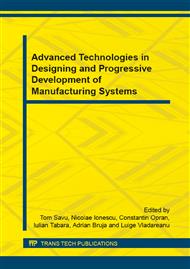[1]
A. Toffler, Future shock, Random House, New York, (1970).
Google Scholar
[2]
S.M. Davis, Future Perfect, Addison Wesley, Boston, (1987).
Google Scholar
[3]
B.J. Pine, Mass Customization, Harvard Business School Press, Boston, (1993).
Google Scholar
[4]
C.W.L. Hart, Mass customization: conceptual underpinnings, opportunities and limits, Int'l J. of Service Industry Management 6, 3 (1995) 36-45.
DOI: 10.1108/09564239510084932
Google Scholar
[5]
B.J. Pine, D. Peppers, M. Rogers, Do you want to keep your customers forever?, Harvard Business Review 73 (1995) 103-114.
DOI: 10.1016/0737-6782(96)82971-7
Google Scholar
[6]
M.M. Tseng, J. Jiao, Mass Customization, in: J. Wiley & Sons, G. Salvendy (Eds. ), Handbook of Industrial Engineering, 3rd Edition, New York, (2001).
Google Scholar
[7]
A.M. Kaplan, M. Haenlein, Toward a parsimonious definition of traditional and electronic mass customization, J. of Product Innovation Management 23, 2 (2006) 168-182.
DOI: 10.1111/j.1540-5885.2006.00190.x
Google Scholar
[8]
B.J. Pine, The state of mass customization and why authenticity in business is the next big issue, B. Joseph Pine in an interview with Frank Piller, Mass Custom Open Innovation News 10 (2007).
Google Scholar
[9]
L. Probst, E. Monfardini, L. Frideres, D. Demetri, A. Kauffmann, S. Clarke, Case study 3 - Mass customisation, Advanced Manufacturing, Business Innovation Observatory (2013).
Google Scholar
[10]
F.T. Piller, Mass Customization: Reflections on the State of the Concept, Int'l J. of Flexible Manufacturing Systems 16, 4 (2004) 313-334.
DOI: 10.1007/s10696-005-5170-x
Google Scholar
[11]
S. Chen, Y. Wang, M.M. Tseng, Mass Customization as a Collaborative Engineering Effort, Int'l J. of Collaborative Engineering 1 (2009) 152-167.
Google Scholar
[12]
J.H. Gilmore, B.J. Pine, The four faces of mass customization, Harvard Business Review 75 (1997) 91-101.
Google Scholar
[13]
C.J. Tuck, R.J.M. Hague, M. Ruffo, M. Ransley, P. Adams, Rapid manufacturing facilitated customization, Int'l J. of Computer Integrated Manufacturing 21, 3 (2008) 245-258.
DOI: 10.1080/09511920701216238
Google Scholar
[14]
Information on http: /papers. ssrn. com/sol3/papers. cfm?abstract_id=1720785.
Google Scholar
[15]
F. Salvador, M. Holan, F. Piller, Cracking the code of mass customization, MIT Sloan Management Review 50 (2009) 70-79.
Google Scholar


